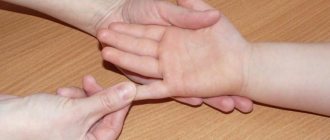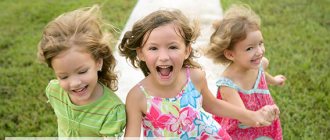Schools and kindergartens let children go on vacation, as did sports clubs. Of course, advanced young athletes have sports camps, but what if the child is involved in some kind of general strengthening sport “for health”, or is still too young to go to the camp? How not to lose your sports uniform during the holidays? Similar to the summer reading list, we offer a set of exercises for children that can be added to their daily summer activities.
Why special exercises if in the summer children are always on the move - riding bicycles, rollerblades, scooters, climbing horizontal bars in playgrounds, jumping on a trampoline in the country or in a children's park, chasing a ball or playing basketball?
Yes, courtyards and sports grounds in large cities today stimulate the motor activity of children, and in the country, many parents consider it necessary to install a sports complex with a rope, rings, a rope ladder, a trampoline, and a swimming pool.
But a lot depends on the child himself and the situation. If he prefers quiet activities to active games, or there is no one to run and play with at the dacha, parents should spend time doing useful gymnastic exercises that will help maintain physical fitness, stretch, improve strength and flexibility. This will take no more than 30 minutes two to three times a day. All these exercises can be performed outdoors, placing a mat on the grass, or at home.
Leg exercises
Jumping rope - forward/backward on two legs, on one leg. At first, children will need their parents' help to understand the essence of jumping rope. Then they can do this exercise on their own.
Jump on two legs, rotating the rope forward and then backward, perform 50 times. Jumping on one leg, rotating the rope forward, 20 times on each leg. If a child is over 10 years old and is in good athletic shape, then the number of jumps on two legs forward/backward can be increased to 100, and on one leg - 30-40 times on each.
Jumping hoops for children under 4 years of age . This exercise will help young children, starting from 1.5 years old, learn to jump on two legs. Buy 5-7 pieces of medium-sized colored hoops, place them on the path one after another and show the children how to jump from one ring to another.
If children do not know how to jump, then parents should help them by holding them by the waist. If the child is already jumping confidently, then increase the distance between the hoops so that he can jump long.
Squat jumps (“frogs”). Starting position: crouching - squatting, keeping your knees together, resting on your hands.
Jump high up, straighten your back and straighten your arms up, then immediately squat down to the starting position and immediately repeat the next jump. 2 approaches with rest 15 times.
Can children do gymnastics?
People who did gymnastics in childhood have much better physical development, stronger immunity, and are less susceptible to diseases of the musculoskeletal system. Therapeutic exercises should be prescribed by a doctor if necessary and indicated. Professional sports require good health and permission from a pediatrician; without a certificate, a child will not be allowed to train. Therefore, before making a decision, you should find out about the indications and contraindications, possible benefits and harms to the body, and consult a doctor. The benefits of gymnastics for children
The benefits of gymnastics for the body are great. Gymnasts boast ideal posture, flexible, easy and flexible movements, and strong muscles. Immunity increases, children get sick less often. Exhausting workouts that require concentration and full dedication perfectly build character, discipline, and develop willpower, attention, memory, and self-confidence. At the same time, children become more artistic, they develop an ear for music and a sense of rhythm.
Exercises for the abs
Lowering/raising the back from a sitting position. Starting position: sitting on the floor, fix your legs under the sofa or your parents should hold them, palms crossed at the back of your head. Slowly lower yourself onto your back, keeping your head on your chest the entire time, and then rise to the starting position without using your hands. Perform 2 sets 15-20 times with a short rest interval.
Raising legs while lying on your back. Starting position: lying on your back, arms along your body. Raising straight legs up to a vertical position and slowly lowering down. The legs must be stretched and tense (2 sets of 15 times with a short rest interval).
Cost - how much do classes at a gymnastics school cost?
Professional gymnastics for children is one of the most expensive sports. Main expenses: suits, sports equipment, individual training, training camps and competitions. If there is no goal to raise your child to be an Olympic champion, but there is a desire to help him develop harmoniously, make his body strong and flexible, you can choose schools with the lowest price. There will be less competition and training costs.
Hand exercises
Plank . Starting position: emphasis lying on the floor, i.e. rest your straight arms and legs on the floor so that your body is parallel to the floor, your shoulders are directly above your palms, your back is slightly rounded, your legs are together. 2 sets of 20 seconds.
Plank on one arm (first on the right, then on the left). Starting position: lying down, press your straight arm to your thigh along the body, do not turn your shoulders, do not spread your legs. 2 sets of 20 seconds.
Champion or health
The most important choice, because professional sports and health are not very compatible things. Most professional schools, which make it a priority to develop champions and prize-winners of world tournaments, conduct strict selection, it is difficult to get there, the training is tough and exhausting physically and emotionally.
Along with such sports schools, there are also general development schools, where they do not choose stars, pay attention to the harmonious development and improvement of the health of children, do not torture them with exhausting training, but they do not put them on a world gymnastics pedestal.
The cost of classes is much higher, since they are held in groups of several people, and group leaders may require individual training with a star trainer. Constant trips to training camps and competitions, costumes and sports equipment require large investments.
Exercises on the horizontal bar
Pull-ups on the bar with external assistance - i.e. the parent holds the child by the stomach and helps him pull himself up. Gradually reduce assistance. It is important that when doing pull-ups, the child maintains a straight body position, does not bend his legs and pulls himself up to the chin (i.e., the chin is higher than the bar). Perform: 2 sets of 10 times.
Emphasis on straight arms on a low crossbar - these can also be parallel bars. Starting position: standing on the crossbar with straight arms, shoulders slightly forward, back rounded, emphasis on hips, legs together. Perform 2 sets of 10-20 seconds.
Moving with your hands on a hanging bar - find any long, high bars, stairs (there are many of these on playgrounds) where the child can hang on his hands and move in different directions without the help of his legs.
Contraindications to gymnastics in children
This sport involves significant physical activity, so the young athlete must be healthy. A child will not be allowed into the gym without a doctor’s certificate stating that there are no health contraindications for doing gymnastics.
Among the medical taboos for this sport:
- myopia, ophthalmological diseases;
- diabetes;
- any diseases of the heart and blood vessels;
- disturbances in the functioning of the musculoskeletal system, advanced scoliosis;
- deviations in the functioning of the nervous system.
All other contraindications are determined individually by the doctor when examining the child. In some cases, there are temporary bans until the ailments are eliminated: any type of hernia, infectious, respiratory and other diseases. After the examination, the pediatrician may prescribe a course of therapeutic exercises if adjustments to posture and the musculoskeletal system are required.
Stretching
At the end of your workout, these exercises will help you relax your muscles and gradually develop flexibility. Children under 3 years old are recommended to complete all tasks except the splits.
Fold the legs together and apart with the help of parents. Starting position: sitting on the floor, legs together, hands reaching towards the legs. Parents lightly press on the back. 2 sets of 10 times.
"Ring". This exercise is aimed at stretching the muscles of the back, shoulder girdle, and front thigh. Starting position: lying on your stomach, lean on your straight arms, which are close to your stomach, and stretch your head up. Then bend your legs and stretch your toes towards the back of your head, trying to touch it. Hold this position for 10 seconds, then rest and repeat again.
The article was prepared by the club "European Gymnastics Center"
Indications
For recreational gymnastics, the doctor determines the indications. You should not decide to perform narrowly targeted exercises on your own. This can lead to disproportionate development of the child, causing more harm.
Among the factors that may contribute to the decision to send a child to the gymnastics section may be the child’s personal desire to become an outstanding athlete, minor posture disorders (only after consultation with a specialist), the parents’ desire to improve the child’s physical characteristics, strengthen character, discipline, develop willpower, make the child is more artistic, more emotional and more self-confident.
The best gymnastics schools in Russia
There are also good schools in large Russian cities, but the best of them are concentrated in the capital. For a career, you can try training in the nearest sections, and if your child wants to develop further in this direction, try enrolling in stellar gymnastics schools.
State Budgetary Institution "MGFSO" MOSKOMSPORT, Moscow
This is the best school in Russia; outstanding athletes studied within its walls: Evgenia Kanaeva, Irina Chashchina and Alina Kabaeva. These names can tell about the professionalism of the coaches working here, who have been producing star athletes for two decades in a row.
Youth and Youth Sports School “Pearl”, St. Petersburg
Among the students of this sports section are famous athletes who are members of the Russian national team, multiple absolute European champions, among them: Averina Dina and Arina, Natalya Safronova, Anastasia Sergeeva, Margarita Mamun and others. The school offers free classes for those who have passed the selection and paid training.
Irina Viner Sports Academy
Irina Viner’s team is the gold and silver medalists of the vast majority of competitions in which the school participates. The training here is tough. A film “Irina” was made about the head coach of the school, which eloquently shows the attitude towards athletes and the severity of everyday training. However, thanks to Irina Viner-Usmanova, who has supported Russia on the highest podium of world competitions for 20 years, dozens of athletes have received fame and recognition.
Gymnastics is hard work, which is rewarded with strong willpower and high physical capabilities. If parents and their children have a desire to gain world fame and fame, then they need to choose a school of the appropriate level. However, you should prepare for hard everyday life, exhausting training, painkillers and emotional pressure from coaches. For general physical development, schools that are less demanding of their students are suitable, which will allow children to develop physical strength, endurance, and improve health.
What tasks should be set for teachers during classes?
During physical education for children 5 years old, the teacher must teach children the following skills:
- Basic movements. With the development of this skill, the baby learns to walk, run, throw objects, jump and climb correctly. This is necessary for future work. If in early childhood a small person did not engage in physical exercise, in adulthood he develops an ugly gait, waddling, scoliosis, flat feet and wide arm swings. Such ailments arise as a result of parental inattention to the child during the preschool period. The teacher shows the children the technique of performing the exercises, and the kids repeat after.
- Equilibrium. An important skill in the life of every person. Exercises to maintain balance develop coordination of movements in preschool children, but, above all, the skill teaches the child to be courageous and persistent. First, classes are practiced on the floor using a special mat: children hold a projectile in their hands, which they move in different directions. Next, sports objects are used - a log or a bench.
Attention! While performing complex exercises, the teacher supports and insures the child to avoid injuries and bruises.










